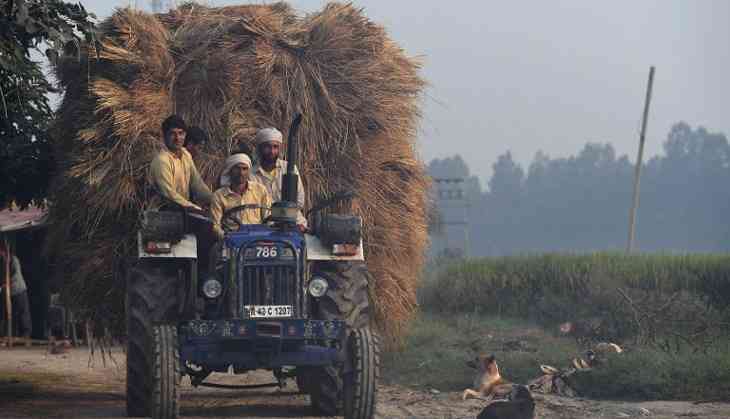In trying to please middle class is Modi govt tightening noose around farmers?

The fine print of the Gujarat state Assembly election result suggests that the farm sector distress has begun to reflect in the Indian politics. Bhartiya Janata Party (BJP) which is ruling the state for 22 years lost more than 50% seats in the rural areas.
Of the 109 seats in rural Gujarat, the BJP lost 66.
This has prompted analysts and commentators to expect a big bonanza from Union Finance Minister Arun Jaitley in his last budget before his government goes to polls in 2019.
However, the questions is, can Jaitley turn around the rural economy with the stroke of a few dole-outs for farmers in his last budget?
And an even bigger question is – has Jaitley ignored farmers in his past budgets?
Not really.
In his 2014-15 budget speech, he mentioned the word farm and farmers 25 times. In the speech delivered in 2015-16, Jaitley used the same words 13 times. And in 2017-18 speech, delivered earlier this year, those words were mentioned 29 times.
The only word that got a higher mention in the budget speech than 'farm' or 'farmers' was 'tax'. The government on its part has tried very hard to be seen as it is doing something for the farmers. Various schemes to improve irrigation, research and credit for the farm sector were announced in this period.
Yet, on an average 12,000 farmers have committed suicide every year since the NDA government came to power. This does not mean that farm suicides began under the rule of the present government, but it does raise questions about the impact of these schemes on the lives of farmers.
So, have the government schemes been miss-targeted?
Agriculture economist YK Alag, who hails from Gujarat says –
“Demonetisation dealt a big blow to the farmers. The Reserve Bank of India did not allow the cooperative banks to exchange notes. Most of the small farmers depend on cooperative banks for working capital loans. That created problem for the farmers across the country, including in Gujarat.”
But as mentioned above, the farm distress has existed for many years in India. Demonetisation only aggravated the situation.
What's been the issue all this time?
There are various factors that affect the farm economy of India.
Noted economist and India's former chief statistician Pronab Sen blames India's monetary policy for increasing distress in the farm sector.
“The Reserve Bank of India has a mandate to control retail inflation in the range of 4%-6%. The moment it goes above 4%, alarm bells ring. This policy requires the government to keep the price of agricultural items artificially low. With low food prices, the government can keep the middle class happy, but it takes away the income of those who produce agri-products,” Sen said.
Sen's point is validated by the fact that food and beverages have a weight of 54.18% in the Consumer Price Index. This basket includes 12 type of products including, Cereals, meat and fish, egg, milk products, vegetables and pulses among others.
The average rate of retail inflation between 2011 and 2013 was 9.69%. Whereas the average rate of retail inflation between 2014 and October 2017 has been 5.03%.
In this period, prices of pulses, vegetables, as well as cereals, have crashed many times leading to loss of farm incomes.
For example, in October 2017, wholesale prices of pulses dropped below the government’s minimum support prices (MSP) despite a lower crop output.
According to a report published by Mint newspaper, “Farmers in Ajmer sold moong (green gram) at an average price of Rs 4,050 per quintal, 27% lower than the government announced minimum support price (MSP) of Rs 5,575 per quintal. Further, wholesale prices of moong are also 29% lower than the costs of production (including imputed rent and interest costs on owned land and capital) at Rs 5,700 per quintal calculated by the Commission for Agricultural Costs and Prices (CACP) under the agriculture ministry.”
Immediately after the government announced demonetisation in 2016, the price of vegetables had fallen by more than 30% in many markets as farmers were forced to sell the perishables at below input cost in the absence of hard cash.
Prices fall on good harvest, prices fall on bad harvest
In a free market economy, as India projects itself to be, the price fluctuation should help both the producer as well as the consumer. A good crop leads lower price realisation for farmers but in the year of a shortfall, farmers should make money by being able to charge more.
But in India, bumper crop brings the prices down automatically and in years of a shortfall, the government intervenes in the market by importing huge quantities of a commodity from other countries at a cheap price.
Devinder Sharma, an agriculture expert and policy commentator, says – “Farmers of India are made to subsidise the food plate of the middle class and the rich. Indian farmer suffers if there is a drought, and he suffers when there is a bumper crop.”
Government policies since 2014 have systematically kept the growth in farm prices low. A research report from ratings agency CRISIL says that the average annual growth (in MSP) between the agriculture year 2009 and 2013 was 19.3%, whereas it was only 3.6% between 2014 and 2017.
While the MSP helps farmers of only the rice and wheat growing states, but it sets the tone for other agri-commodities as well.
The argument that price rise is bad for poor
There is no doubt that in a country with 21.9% people living below poverty line (read Tendulkar committee) and high food prices will make it difficult for them to break the shackles of penury. One can argue that between farmers and the poorest among the poor, the government should favour the latter. But Pronab Sen argues against this.
“To take care of the poor, we need to focus on Public Distribution System (PDS), rather than keeping the food prices low. If there is a direct distribution of food articles to the poor, the farmers can be pulled out of the current situation,” he explained.
Sen emphasises that to improve the lives of poor, the government should pump in more money in the rural economy. Because that is where most poor live. The current model is urban-centric development.
The model recommended by Sen was experimented with for some time before 2014. It had actually resulted in higher consumption by rural India.
According to the consumer expenditure survey of the National Sample Survey Organisation From 2007-08 to 2011-12, the monthly per-capita consumption expenditure (MPCE) in rural areas increased at a compound annual rate of 16.7 %, compared with 15.6% in urban centres, reported the Business Standard.
This was the period when most FMCG and automobile companies started considering rural India as their next growth market.
But what happened then?
One of the biggest problems with inflation – especially food and fuel – is that it enrages the middle class and the media. The Modi government had made food inflation a big issue in its election campaign in the run-up to the 2014 Lok Sabha elections. After the new government came to power, despite keeping retail inflation substantially low, it has faced criticism from the opposition and threats of high interest rates from the RBI.
Therefore allowing the food prices to go up will require the government to go against the urban class that is vocal in the media and has the power of influencing popular opinion.
Is there no way out?
Sen argues that there is. It is a difficult task but the government must attempt to come up with policies that allow a reduction in non-food product prices and a decent hike in the price of food products. “This will keep over-all inflation under check giving a boost to the rural economy and farmers,” Sen explained.
YK Alag on his part talks about the need of creating a modern infrastructure to allow farmers to be able to sell their products in cities.
“If you go to European countries, their farmers come to dedicated places in every big city, sell their products and go back. In India, there is no such infrastructure,” he pointed out.
And what happens to the promise of doubling farm incomes by 2022?
Alag outrightly calls this promise delusional.
“For that to happen in real terms, India's agriculture will have to grow at 15% for 6 years. It has not happened anywhere in the world,” Alag says.
Between 2012-13 and 215-16, India’s agriculture has grown by a meagre 1.9%.
Clearly, resolving the farm distress is an uphill task. Jaitley will require more than a budget speech, a few schemes and grand promises to fix the problem.
First published: 22 December 2017, 18:01 IST

